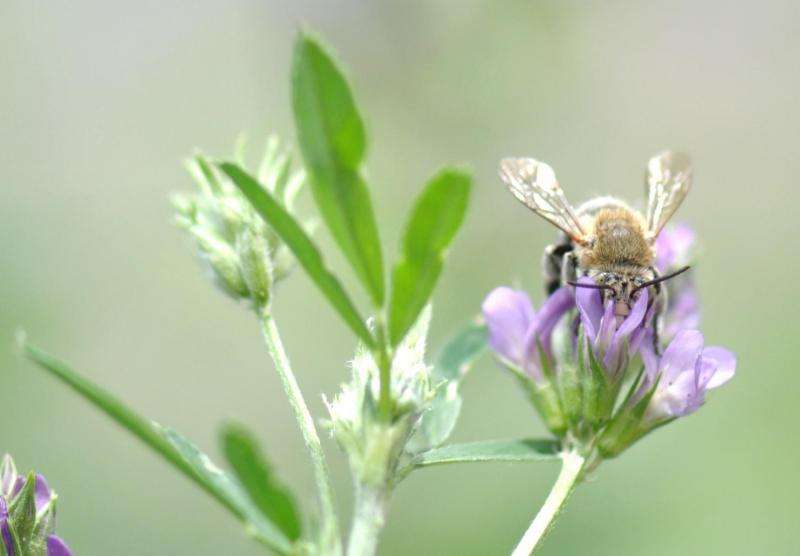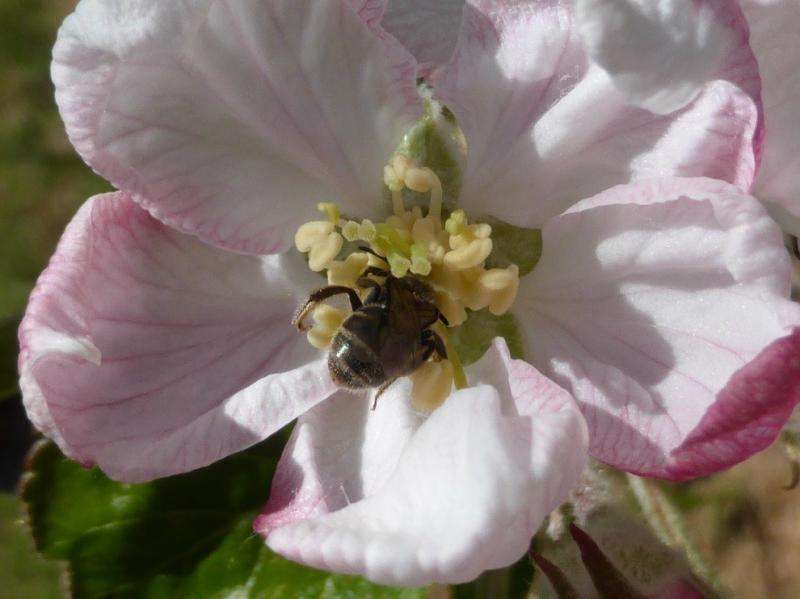A native blue-banded bee pollinating lucerne. Credit: K. Hogendoorn
The University of Adelaide, working with South Australian industry groups, is helping farmers and growers design and implement native plantings to support bee and other insect populations needed to pollinate their crops and orchards.
This is the first such project in Australia – expected to be a win-win for both growers and biodiversity, with enhanced productivity through improved pollination and increased biodiversity through revegetation with native plants.
"We know that crop pollination can be improved by revegetation on or around farms that supports pollinators. It's a strategy used in major horticultural regions in Europe and the US, but not yet in Australia," says project co-leader Dr Katja Hogendoorn, from the University's School of Agriculture, Food and Wine.
Crops such as lucerne, almonds, apples and cherries rely on insect pollinators to pollinate their flowers to produce seeds, nuts or fruit. Canola yield and quality can also be improved with good pollination services.
"Like humans, bees need a varied diet, so, in the case of bees, pollen and nectar from a range of flowers. Crops provide one-sided nutrition and when they finish flowering, there is often very little alternative food for pollinators present in the landscape. We are looking to improve the landscape to secure pollinator populations and their crop pollination services," Dr Hogendoorn says.
Researchers from the University of Adelaide are mapping the activity of honeybees and native pollinators in areas of revegetation and native vegetation around different crops in South Australia. They will create a short-list of the most useful pollinating species and identify the plants used by the pollinators as sources of pollen and nectar. This will allow strategic choices in revegetation with a selection of the plants that benefit crop pollinators.
A native furrow bee pollinating apple. Credit: M. Saunders
"An important outcome from the project will be planting guides and a web-based tool which will enable users to map vegetation plantings around their crops that will provide the best habitat for pollinators in order to maximise productivity gains," says project co-leader Professor Andrew Lowe, Chair of Plant Conservation Biology in the University's Environment Institute. "This project is a great example of how the University is using innovative thinking to improve productivity and sustainability in cropping and food."
Project partners include Lucerne Australia, Apple and Pear Growers of SA, Trees for Life, O'Connor NRM, Primary Industries and Regions SA (PIRSA), Department of Environment, Water and Natural Resources; Almond Board of Australia, Native Vegetation Council, Greening Australia, South Australian Apiarist Association, various NRM boards and Rural Industries Research and Development Corporation.
The University of Adelaide will further collaborate with the University of Sydney to assess local densities of wild honey bees in pollination dependent crops and with the University of New England and ANU to understand the economic value of individual crop pollinating species for different crops.
This project is supported through funding from the Australian Government Department of Agriculture and Water Resources as part of its Rural R&D for Profit Programme. The total value of the project is $9M, of which $4.5M is allocated to activities in South Australia.
Susie Green, Executive Officer, Apple & Pear Growers Association of SA: "We are hopeful that the project will provide apple and pear growers with the knowledge and tools to boost their pollination efficacy by providing food sources for native bees, feral honey bees and hived bees."
Provided by University of Adelaide























